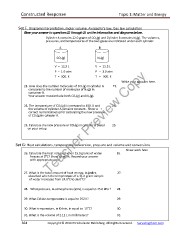Page 374 - Teacher Preview Copy
P. 374
Constructed Response . Topic 1: Matter and Energy
Set F. Diagram interpretation, molar volume, Avogadro’s law, Gas law calculation
Base your answer to questions 23 through 25 on the information and diagrams below.
Cylinder A contains 22.0 grams of CO2(g) and Cylinder B contains N2(g). The volumes,
pressures, and temperatures of the two gases are indicated under each cylinder.
A B
CO2(g) N2(g)
V = 12.3 L V = 12.3 L
Teacher Preview Copy
P = 1.0 atm P = 1.0 atm
T = 300. K T = 300. K
Write your answers here.
23. How does the number molecules of CO2(g) in cylinder A 23.
compares to the number of molecules of N2(g) in
container B.
Your answer must include both CO2(g) and N2(g).
24. The temperature of CO2(g) is increased to 450. K and 24.
the volume of cylinder A remains constant. Show a
correct numerical setup for calculating the new pressure
of CO2(g) in cylinder A.
Teacher Preview Copy
25. Calculate the new pressure of CO2(g) in cylinder A based 25.
on your setup.
Set G: Heat calculations, temperature conversion, pressure and volume unit conversions
Show work here
26. Calculate the heat released when 25.0 grams of water 26.
o
freezes at 0 C? Show all work. Record your answer
with appropriate unit.
27. What is the total amount of heat energy, in joules, 27.
absorbed when the temperature of a 31.0 gram sample
o
o
of water increases from 24.0 C to 36.0 C?
28. What pressure, in atmospheres (atm), is equal to 45.6 kPa ? 28.
29. What Celsius temperature is equal to 252 K? 29.
o
30. What temperature, in Kelvin, is equal to 15 C? 30.
31. What is the volume of 2.12 L in millimeters? 31.
364 Copyright © 2010 E3 Scholastic Publishing. All Rights Reserved. Survivingchem.com
Set F. Diagram interpretation, molar volume, Avogadro’s law, Gas law calculation
Base your answer to questions 23 through 25 on the information and diagrams below.
Cylinder A contains 22.0 grams of CO2(g) and Cylinder B contains N2(g). The volumes,
pressures, and temperatures of the two gases are indicated under each cylinder.
A B
CO2(g) N2(g)
V = 12.3 L V = 12.3 L
Teacher Preview Copy
P = 1.0 atm P = 1.0 atm
T = 300. K T = 300. K
Write your answers here.
23. How does the number molecules of CO2(g) in cylinder A 23.
compares to the number of molecules of N2(g) in
container B.
Your answer must include both CO2(g) and N2(g).
24. The temperature of CO2(g) is increased to 450. K and 24.
the volume of cylinder A remains constant. Show a
correct numerical setup for calculating the new pressure
of CO2(g) in cylinder A.
Teacher Preview Copy
25. Calculate the new pressure of CO2(g) in cylinder A based 25.
on your setup.
Set G: Heat calculations, temperature conversion, pressure and volume unit conversions
Show work here
26. Calculate the heat released when 25.0 grams of water 26.
o
freezes at 0 C? Show all work. Record your answer
with appropriate unit.
27. What is the total amount of heat energy, in joules, 27.
absorbed when the temperature of a 31.0 gram sample
o
o
of water increases from 24.0 C to 36.0 C?
28. What pressure, in atmospheres (atm), is equal to 45.6 kPa ? 28.
29. What Celsius temperature is equal to 252 K? 29.
o
30. What temperature, in Kelvin, is equal to 15 C? 30.
31. What is the volume of 2.12 L in millimeters? 31.
364 Copyright © 2010 E3 Scholastic Publishing. All Rights Reserved. Survivingchem.com


